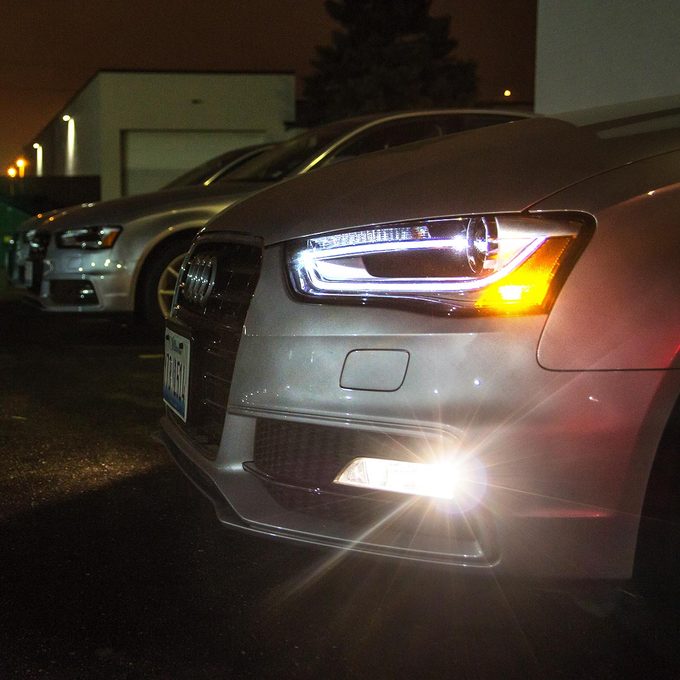Headlight glare giving you a headache? We talked to automotive experts to get the inside scoop on why cars seem brighter than ever before.

Are Car Headlights Much Brighter All of a Sudden—Or Is It Your Imagination?

Is it me, or are headlights getting ridiculously bright these days? You know the feeling: You’re bopping along the road, lost in your music or a podcast, when suddenly two laser beams shoot over the top of a hill and directly into your eyes. Or maybe you’re at a drive-thru getting a late-night snack, only to be nearly blinded by an unsettling blast of light. (That little flipper on your rearview mirror seems totally inadequate, doesn’t it?)
Is everyone driving around with their high beams on? And if not, what’s changed with today’s vehicles to make this such a common occurrence? To find out, I consulted Greg Brannon, director of automotive engineering at the American Automobile Association (AAA), and Matt Brumbelow, principal research engineer at the Insurance Institute for Highway Safety (IIHS).
Spoiler alert: It’s not just me. But there’s actually a reasonable explanation. Read on for more.
Get Reader’s Digest’s Read Up newsletter for more car news and tips, humor, travel, tech and fun facts all week long.
Are headlights actually brighter than they used to be?
They do appear brighter, but Brumbelow says the question of headlight brightness is “less straightforward than it would appear,” and Brannon cautions that brightness is not a technical or research-based term. Of course, when you’re staring into an oncoming vehicle’s lights, you might not appreciate the distinction.
Much of the perception of brightness has to do with the color, size and beam pattern of today’s light-emitting diode (LED) headlights. Gone are the days of the soft, amber glow of traditional halogen headlights. We’ll explain the nuts and bolts below, but here’s the gist: Unfortunately, the brightness of a headlight can’t be distilled into a single value, Brumbelow says.
What’s changed with headlight technology?
A lot. Brannon says light levels allowed on the road by the federal government’s headlight standards have remained unchanged since the middle of the 1980s, when the standards were last updated. So why do they look so bright? Carmakers have instead “gotten better at being able to get up to that maximum light output that’s allowed,” Brannon says.
Changes to three major aspects of car headlights affect brightness, and they all have to do with LED technology:
- Light source: For decades, carmakers used simple round or square globe headlights with a filament inside, just like a standard incandescent light bulb. These cast a broad, dissipated glow and weren’t very focused on the roadway. The concentrated light from tiny LEDs can look like a laser in comparison.
- Color temperature: Unlike the warmth of a halogen bulb, most LEDs “are bright white, even leaning toward blue in the spectrum,” Brannon says. Brumbelow adds that “LEDs with bluer output are often perceived as brighter, even at the same illuminance value.” (Illuminance describes how much light reaches a surface.)
- Beam pattern: Instead of a single filament for each low and high beam, LED headlights use an array of multiple diodes that can be individually directed. “A good beam pattern is one that gives the driver of the vehicle sufficient illumination to safely perform the driving task without creating glare that affects the ability of other road users to travel safely,” Brumbelow says.
When did this start?

Audi started the trend in 2004 with LED daytime running lights, but the first car to have LED headlights was the 2007 Lexus LS 600h. The 2008 Audi R8 followed with an all-LED setup: headlights (including low and high beams), daytime running lights and turn signals.
A staple of mostly luxury vehicles through the late 2000s, LED headlights now appear on cars of all classes. The National Highway Traffic Safety Administration says nearly three-quarters of cars sold in 2023 had them.
Which types of cars are affected?
All of them. Brannon says you can still buy halogen lights on a few economy cars—and, of course, used cars manufactured years ago still have them—but in general, automakers are moving toward LEDs if they’re not there already.
“I think in the coming years, you’ll struggle to find a car that has a halogen-type bulb,” he says.
What are the benefits of these new headlights?
Even though these headlights can be startling, especially if you’re not prepared for them, they do have multiple benefits, experts say.
They’re safer
Brannon says research shows that when driving with old-style halogen headlights on an unlit road, “you can out-drive your headlights at 45 miles an hour.”
Out-drive your headlights? Here’s what he means: “If there’s no other light on the road and you’re relying strictly on your low-beam headlights, by the time you see something, react to it and then allow the vehicle to come to a stop, you will have hit it [if you’re going] above speeds of about 45 miles an hour,” he says.
In other words, halogen headlights don’t illuminate enough of the road to keep you safe at high speeds on dark roads.
Since the vast majority of pedestrian deaths happen at night, LED lighting systems are “safer, and they will bring safety to the roadway,” Brannon says.
They’re more reliable
If you’re of a certain age, you probably remember seeing cars with one burned-out headlight. (We used to yell “perdiddle!”) Plus, you had to swap out those broken headlights from time to time. With newer LEDs, “you do not have to replace bulbs continually, like you did on older halogen systems,” Brannon says. Light-emitting diodes last up to 25 times longer than halogen incandescent lamps.
They’re more efficient
Because they’re so small and energy efficient, LEDs draw much less power from your car’s battery than traditional headlights. “The more power that you’re drawing from the battery, the more load there is on the engine,” Brannon says.
So while it might not seem intuitive, new LED headlights actually have a positive effect on fuel economy and engine performance.
They’re more versatile
Instead of having one fixed bulb that sends out light in a broad circle, LED headlights “do a lot better job of putting the lighting where it needs to be,” Brannon says. That’s because the LED arrays can be precisely aimed, turned off and on, and programmed to adjust to driving conditions, like going around a curve.
Brannon says two (confusingly named) headlight technologies are here or coming soon.
- Adaptive headlights use LEDs mounted “sort of like fog lights or in the corner of the light, so whenever you’re going around the corner, it will light up around that corner.”
- Adaptive driving beam (ADB) headlights have been available in Europe for many years, and these automatically change the beam pattern of the LEDs to reduce glare for oncoming drivers—without reducing your car’s forward lighting.
“It’s really cool technology,” Brannon says. “We have tested it pretty extensively with some European-equipped vehicles and found it to be quite effective.” He and AAA lobbied to have the United States adopt European standards for ADB headlights, but instead, regulators wrote new standards; they were approved in 2022, so cars with this tech are not on the road just yet.
What are the drawbacks of these new headlights?
In a word: Glare.
Despite improvements in technology and safety, “there are many reasons that drivers may experience uncomfortable levels of glare from other vehicles,” Brumbelow says.
They’re distracting
When someone in a giant SUV rolls up behind you, the last thing you want to hear is that LEDs are perfectly normal. Remember the beam pattern Brumbelow mentioned earlier? “Sometimes the brighter visibility portion of the beam pattern will be directed toward other drivers, whether because of misaim, headlight heights farther from the ground (as on taller SUVs or pickups) or simply from road geometry, such as when a vehicle crests a hill,” he says.
Brannon says older adults and people who wear glasses can be particularly vulnerable to glare, especially when a vehicle is coming right at them. “AAA’s advice on this is: Whenever you find yourself in that situation, look at the white line on the side of the road—do not look into the headlights,” he says.
They’re available for aftermarket sale
Brumbelow says you can buy aftermarket LED bulbs and install them on cars that weren’t designed for LEDs, “which means the glaring parts of the beam pattern likely no longer meet regulatory requirements.” Even though these lights are illegal, it’s up to states to enforce these laws, “and this is not happening.”
Are these new lights dangerous for drivers?
According to Brannon and Brumbelow, no.
“IIHS rates headlights based on both visibility and glare illumination,” Brumbelow says. “Crash data show that vehicles with good ratings for visibility are involved in 19% fewer single-vehicle nighttime crashes per mile than vehicles with poor ratings.”
But it’s not just about visibility. “Our tests show that headlights are generally improving both by providing more illumination on the road and less light directed upward where it can cause glare,” he says. “Some of this is not from changing the headlight output at all but from improving aim—pointing the light where it should be.”
Many drivers have a different take. Organizations like the Soft Lights Foundation and a popular subreddit with a potty-mouthed name and more than 40,000 members are leading efforts to reduce or otherwise regulate the brightness of LED headlights.
Can you change the brightness of your headlights?
You can’t change the brightness itself, but you can have the aim adjusted. You can also change out the headlights, but since cars are sold with the headlights specifically calibrated for your vehicle model, it’s best to consult a qualified technician.
About the experts
|
Why trust us
At Reader’s Digest, we’re committed to producing high-quality content by writers with expertise and experience in their field in consultation with relevant, qualified experts. We rely on reputable primary sources, including government and professional organizations and academic institutions as well as our writers’ personal experiences where appropriate. For this piece on unlocking electronic car doors, Ally Childress tapped her experience as a longtime journalist and licensed electrician to ensure that all information is accurate and offers the best possible advice to readers. Read more about our team, our contributors and our editorial policies.
Sources:
- Greg Brannon, director of automotive engineering and industry relations for the American Automobile Association; phone interview, Jan. 24, 2025
- Matt Brumbelow, principal research engineer for the Insurance Institute for Highway Safety; email interview, Jan. 29, 2025
- MotorTrend: “Audi Debuts World’s First LED Headlights”
- ABC 25 WBPF News: “Brighter Headlights: The Trend with LED Headlights and What Officials Want You to Know”























